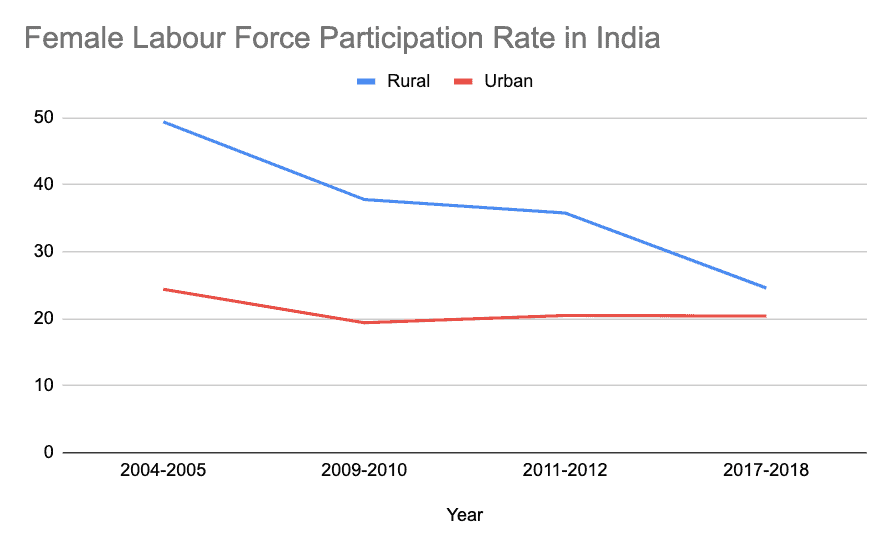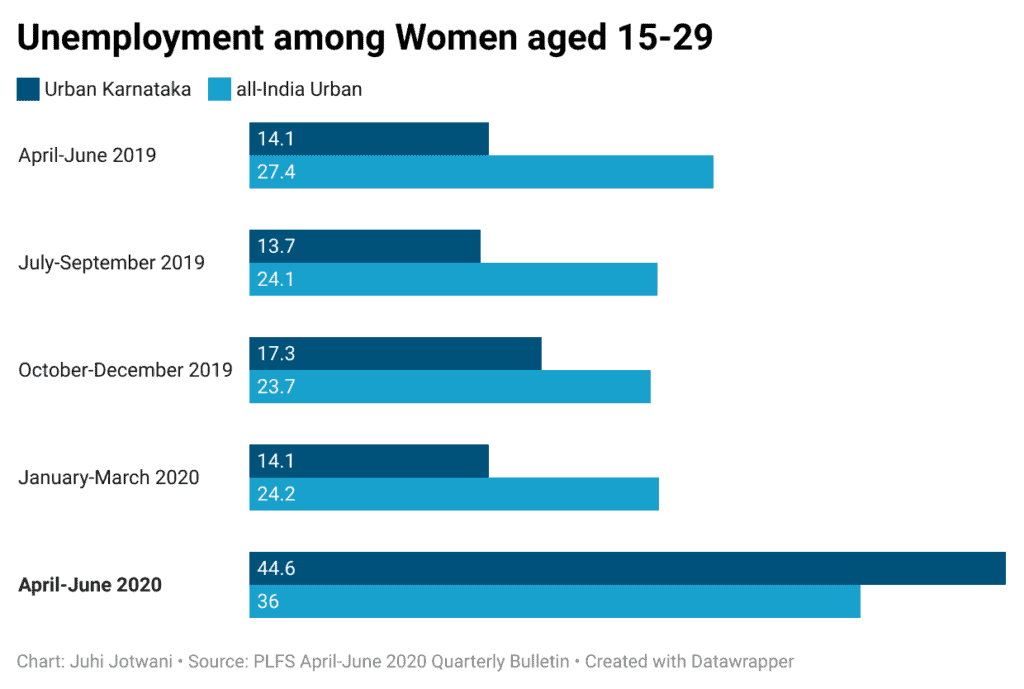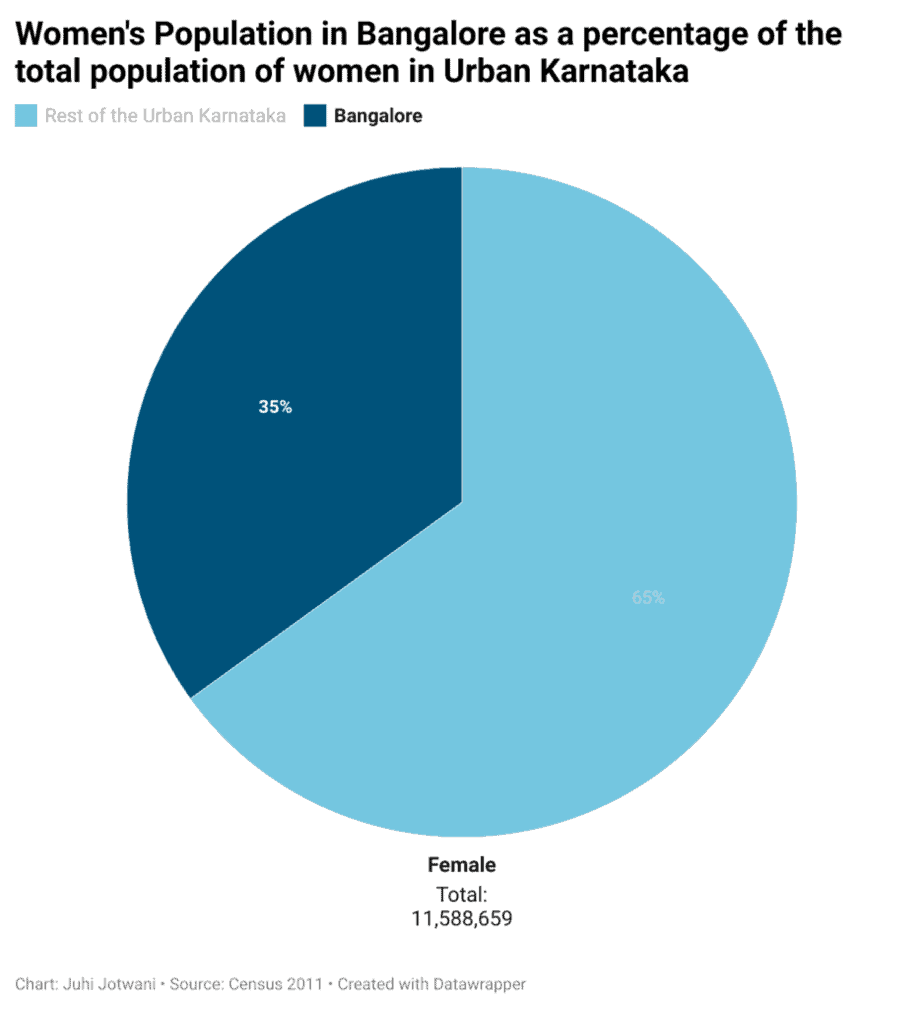In March 2020, Lakshmi’s employer asked her to take a week’s leave. After the week, Lakshmi, a domestic worker, was asked to not come to work for another month. After that, her employer stopped picking her calls and that is how she realised that she had been let go. Lakshmi’s story is not unusual. This one narrative from a Bengalurean woman finds itself reflected in large-scale numbers seen in published reports.
The Global Gender Gap Report 2021 saw India slipping down 28 places and being ranked at 140th position among 156 countries. One of the parameters this report looks at is economic participation and opportunity. While the pandemic has unduly affected women as compared to men all over the world, India has been particularly failing at improving women’s economic situation for several years now. India was already at the 10th position from the bottom when it came to Women’s Labour Force Participation Rate (LFPR) in 2017-18. It is also worrying that this rate has only been declining for a while now.
How has urban India been faring as opposed to rural India?
The situation is different in urban areas and rural areas across the various states in the country. While the Women’s LFPR has been stable and not really declining in urban India, it is still lower than that in rural India.

What does the Periodic Labour Force Survey for April – June 2020 say?
The most recent Periodic Labour Force Survey was released by the Government for the quarter of April – June 2020. It gives data for unemployment and employment of workers in different kinds of work for the urban parts of India. The much-awaited data shows the exact extent of the decline in the economic situation, especially in urban India affected most by the pandemic.
Read more:
How has urban Karnataka fared in regards to women’s work?
As expected, the unemployment rate has gone up, and the already bad situation of women’s work has worsened but this data differs across states. Urban Karnataka’s numbers regarding its young women’s workforce are particularly interesting in two ways.
On average, women’s labour force participation in the age group of 15-29 had reduced from 19.3% to 17.8% from the quarter of Jan-March 2020 to April-June 2020 in India. But surprisingly, Urban Karnataka has seen a rise in women’s participation in labour force from 22.1% to 27.2% in the same quarter. Women’s Labour Force Participation means employed as well as unemployed women who are either working or seeking work. This means more women in Urban Karnataka have joined the workforce.

The above chart shows how the women aged 15-29 in Urban Karnataka are actually showing a more positive trend as compared to the urban figures for all-India. This can be because more women are choosing to work as the other income streams in their family have gone down or perhaps they are being pressurised to work instead of studying.
In any case, more participation in the labour force would have been a good thing if only the unemployment figures would also align with this.

Urban Karnataka’s unemployment rates have generally been better than the all-India urban unemployment rates, as can also be seen in the numbers from April 2019 – March 2020 in the above chart. But, in the period of April – June 2020, the status of women aged 15-29 has taken a huge hit when it comes to unemployment. Women’s unemployment rate for this age group has increased from 14.1% in Jan-March 2020 to 44.6% in April-June 2020 in Urban Karnataka, which is a drastic change for a single quarter. These are women who were in the labour force but failed in acquiring any kind of employment. A 44.6% unemployment rate means that almost every second woman aged 15-29 who was seeking work in Urban Karnataka was unemployed during this quarter. This 44.6% unemployment figure is even worse than the average national figure of 36% for women from the same age group, which is a huge red flag.
Read More: Survey: Garment factory workers say they won’t, and can’t, work longer hours
If we look at the two charts above together, they indicate that while more women in Urban Karnataka may be seeking work during this quarter, they were certainly not getting a lot of work. As this figure is even worse than the all-India figure, there are serious challenges to women’s economic opportunities that Karnataka will have to face.
How does this affect Bengalurean women workforce?
All the above data is for urban Karnataka but since Bengaluru is the biggest urban agglomeration in Karnataka, these figures are quite likely indicative of the situation here. After all, the women’s population in Bengaluru forms 35% of the total women’s population in Urban Karnataka. Women aged 15-29 further make up around 32% of Bengaluru’s female population.

Shriya Anand, an urban scholar whose research focus has been on the role of employment in urban development and poverty reduction, sheds light on what these numbers might mean on the ground. “In Bengaluru, in that age group of women (15-29), the largest employer is the garment industry. This we know from Census Data. What we also know is that in that quarter is that a lot of garment factories actually shut down and lots of them laid off thousands of women in a short period of time.”
Since PLFS works with a longitudinal panel (where observations are repeated for the same set of subjects), we can track the employment status of the same households to better understand mobility and shifts in employment. At an all-India level, these numbers are quite stark. 41% of women who were engaged in casual labour have found themselves unemployed in this quarter and almost 24% of them have exited the labour force. Less than 30% of them have retained their jobs. If Bengaluru’s trends match this anywhere closely, it was a serious situation especially for the women casual labourers for the region, who are anyway quite vulnerable.
Rosa Abraham, Amit Basole, and Surbhi Kesar have also very recently released the report of their analysis of Indian Panel Data when it comes to shifting employment trajectories. They find that while a large chunk of men were able to recover their livelihoods in the following quarter, the same was not the case for women. In fact, women were found to be seventeen times less likely to recover their jobs in the next quarter. This indicates a more long-lasting impact of the lockdown on women as compared to men.
While the PLFS Bulletin of July-September 2020 will take more time to release, we do have Lakshmi’s narrative. While she is working now, her income has halved and uncertainty remains, as Bengaluru experiences the second wave of infections. More research needs to be done by Bengaluru civil society organisations and the government to understand the exact nature of the impact the pandemic has had on women’s economic condition in the city in order to plan better and take measures for their welfare and economic security.
Also read:
- What Women’s Day means for Bengaluru’s women labourers
- B’luru lockdown: Garment workers face uncertainty, factory owners unwilling to pay wages
(With inputs from Divij Sinha, Data Scientist and Faculty, Urban Informatics Lab, Indian Institute of Human Settlements)
Sharp unemployment rise in 2021 as well